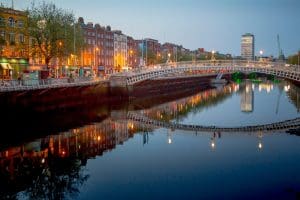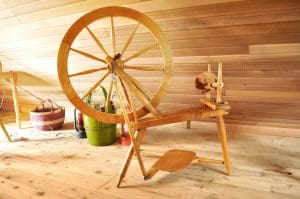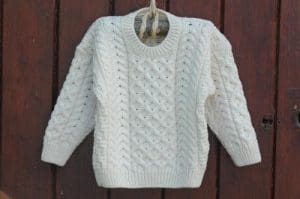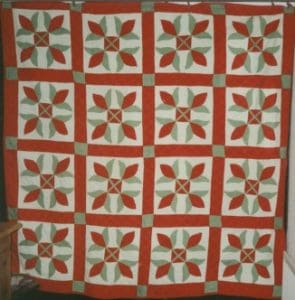Ireland, Irish Éire is a nation of western Europe possessing five-sixths of the westernmost significant island of the British Isles.

Ireland is likewise prestigious for its abundance of old stories, from stories of little leprechauns with concealed pots of gold to that of the supporter holy person, Patrick, with his amazing freeing the island of snakes and his rumored utilization of the three-leaved shamrock as an image for the Christian Trinity.
Despite the fact that Ireland is presently both urbanized and Europeanized, its way of life holds numerous one of a kind attributes, and its kin prize folkloric and social conventions that to a great extent get from and praise the nation’s country past.


Irish culture has affected different societies, particularly in the field of writing. Close by standard Western culture, a solid indigenous culture exists, as communicated through Gaelic games, Irish music and the Irish language. The island’s way of life imparts numerous highlights to that of Great Britain, including the English language, and sports, for example, affiliation football, rugby, horse dashing, and golf.
LANGUAGES
The two official dialects of the Republic of Ireland are Irish and English. Every language has delivered vital writing. Irish, however now just the language of a minority, was the vernacular of the Irish individuals for a huge number of years and was potentially presented during the Iron Age. It started to be recorded after Christianization in the fifth century and spread to Scotland and the Isle of Man, where it advanced into the Scottish Gaelic and Manx dialects separately.
English in Ireland was first presented during the Norman intrusion. It was spoken by a couple of workers and traders brought over from England, and was to a great extent supplanted by Irish before the Tudor success of Ireland. It was presented as the official language with the Tudor and Cromwellian successes. The Ulster estates gave it a perpetual traction in Ulster, and it remained the official and high society language somewhere else, the Irish-talking chieftains and respectability having been ousted. Language move during the nineteenth century supplanted Irish with English as the primary language for a greater part of the populace.
Under 10% of the number of inhabitants in the Republic of Ireland today speak Irish normally outside of the instruction framework and 38% of those more than 15 years are named “Irish speakers”. In Northern Ireland, English is the true official language, yet official acknowledgment is stood to Irish, including explicit defensive measures under Part III of the European Charter for Regional or Minority Languages. A lesser status (counting acknowledgment under Part II of the Charter) is given to Ulster Scots tongues, which are spoken by generally 2% of Northern Ireland occupants, and furthermore spoken by some in the Republic of Ireland. Since the 1960s with the expansion in movement, a lot more dialects have been presented, especially getting from Asia and Eastern Europe.
Shelta, the language of the migrant Irish Travelers is local to Ireland.
CULTURE
Culture incorporates language, writing, music, workmanship, fables, cooking, and game related with Ireland and the Irish individuals. For a large portion of its written history, Irish culture has been essentially Gaelic. It has additionally been impacted by Anglo-Norman, English and Scottish culture. The Anglo-Normans attacked Ireland in the twelfth century, and the sixteenth/seventeenth century victory and colonization of Ireland saw the rise of the Anglo-Irish and Scots-Irish (or Ulster Scots).
The social milieu of Ireland has been molded by the dynamic interaction between the antiquated Celtic customs of the individuals and those forced on them from outside, quite from Britain. This has delivered a culture of rich, particular character in which the utilization of language—be it Irish or English—has consistently been the focal component. As anyone might expect, Irish culture is most popular through its writing, dramatization, and melodies; most importantly, the Irish are prestigious as experts of the specialty of discussion.
Ireland has a few unmistakable local societies as opposed to a solitary national one; besides, the day by day lives of city occupants are somehow or another entirely different from those living in the open country.

Any place they live, the Irish keep up an energetic and exuberant society culture. Thousands take an interest in the nation’s various beginner melodic, move, and narrating occasions. A large number of likewise take part in an assortment of specialty based ventures, creating things, for example, glass, pottery, ironwork, wood-turning, cloths, weaving, and knitwear, served by the Crafts Council of Ireland (situated in Kilkenny) and a yearly exchange reasonable Dublin. Irish style has progressed past the still-well known Aran sweater, with different originators setting up design slants that have wide intrigue both broadly and globally.
Ireland stays home to a portion of the world’s best lagers, bourbons, and different spirits, which go with the vivacious music and mingling that appear to fall into place easily for the Irish and the individuals who visit. Customary Irish music—utilizing privately made instruments, for example, the fiddle, the tin whistle, and the uilleann pipes (Irish bagpipes)— is performed at numerous bars, and conventional tunes are frequently sung there in Irish, now and again joined by the Celtic harp. The céilí, a customary melodic get-together, is a suffering articulation of Irish public activity that has partners in other Celtic societies. Such social events, just as recruiting fairs, steers shows, and different celebrations, for the most part include privately created lagers and bourbons and conventional nourishments, for example, soft drink bread, corned meat, and colcannon (a stew of potatoes and cabbage).


The national occasion in the Republic of Ireland and Northern Ireland is Saint Patrick’s Day, that falls on the date 17 March and is set apart by marches and celebrations in urban communities and towns over the island of Ireland, and by the Irish diaspora around the globe. The celebration is in recognition of Saint Patrick, the supporter holy person of Ireland.


IRISH CUISINE

Irish food is the style of cooking that began from Ireland, an island in the North Atlantic; or was created by the Irish individuals. It has developed from hundreds of years of social and political change, and the blending of the various societies in Ireland, dominatingly the English and Irish-European (and, in Ulster, the Scottish). The cooking is established upon the harvests and animals cultivated in its calm atmosphere and the bounty of new fish and fish from the encompassing clean waters of the Atlantic Ocean.

By the 21st century, a lot of Irish food was being restored. Delegate conventional Irish dishes incorporate Irish stew (made with sheep, lamb, or meat), bacon and cabbage (with potatoes), boxty (potato hotcake), pamper (wiener, bacon, and potato), colcannon (squashed potato, kale or cabbage, and spread), and, in Ulster, the soft drink farl. Current Irish Food despite everything utilizes these conventional fixings however they are presently being cooked by culinary experts with world impacts and are introduced in a progressively present day imaginative style.

Conventional nourishments incorporate bread, pork dishes, potato dishes and ocean bottom.
THEATRE

Irish accomplishments in the performance center adversary those in writing. Two Irish playwrights won Nobel Prizes for Literature, George Bernard Shaw (1925) and Samuel Beckett (1969), and a few others, including Oliver Goldsmith, Richard Brinsley Sheridan, Oscar Wilde, John Millington Synge, and Sean O’Casey, are additionally known all through the English-talking world.

Dublin is the focal point of Ireland’s showy life.
MUSIC AND DANCE


Irish customary melodic structures date from preliterate occasions. The Irish harp since quite a while ago had been the main instrument played, however numerous different instruments, for example, the uilleann pipes, the fiddle, and the accordion—were included later.
The restoration of customary music in the late nineteenth and mid twentieth hundreds of years was trailed by a significantly increasingly enthusiastic resurgence starting during the 1960s. Irish tunes increased wide intrigue in Europe in the nineteenth century, and the music taken to the United States by Irish settlers got one of the chief wellsprings of customary American music. Irish conventional performers, for example, the Clancy Brothers, Planxty, the Boys of the Lough, Clannad, and the Chieftains have visited a significant part of the world. Progressively urban and common laborers based music and melody have been spoken to by gatherings, for example, the Dubliners and the Wolfe Tones. Enthusiasm for Irish customary music was incredibly helped by a vogue for Irish bars that spread over the world.


Ireland has a long convention of people moving. Solo moving is portrayed by its lightning footwork and high kicks, all executed while the chest area is kept unbendingly straight; dances and reels have consistently been well known. The enthusiasm for Irish moving, which developed apace with the restoration of customary music, drove during the 1990s to the formation of the presentation work River move, which accomplished global approval and started the establishing of move organizations around the globe that investigated this style.
EDUCATION
Essential schooling is free, necessary, and for the most part strict denominational. There are a few state-supported educators universities. The auxiliary educational system involves tuition-based schools that are dominatingly possessed by strict networks yet get the vast majority of their financing from the state; thorough and network schools, which are totally state-claimed; and professional schools, which give scholastic just as professional courses prompting capabilities in design, bookkeeping, building, registering, gadgets, and comparable callings.
IRISH FASHION
The Irish design and material industry has had an immense impact on Ireland’s social, social and financial turn of events. Since its commencement Ireland has moved from an agrarian to modern, to an assistance or information-based economy. The Irish material and design industry has followed that development as well as in numerous regards has both caused and affected such turn of events.
Ireland’s primary financial asset is its huge fruitful fields. There has consistently been a significant interrelationship between Ireland’s horticultural and material enterprises. The material business depended on assets gave by horticulture, for example, fleece and flax, while the cultivating business regularly depended on the material and apparel industry as a business opportunity for its produce yet in addition as a wellspring of strengthening income and work throughout the winter months and helpless harvests.
Ireland’s two prevailing indigenous materials are fleece and cloth.

- Wool Spinning: Lillias Mitchell was the one to locate the Irish Guild of Weavers, spinners and dyers in 1975 in Dublin, where she showed numerous understudies. It customarily included taking the downy of a sheep and preparing the crude strands utilizing a turning wheel to make woolen string for sewing and weaving.

- Hand Weaving Tweed: Weaving to a great extent ceased to exist during the Great female, however it made due in specific regions and was verifiably connected with Country Donegal from the 1800’s. A weaver took woolen strings and made them into a material utilizing a wooden handloom. A decent weaver could create up to 30 yards of tweed material every day.
- Hand Knitted Aran Sweaters: Knitting was empowered on the Aran Islands, of the west shoreline of Ireland, from 1890 onwards, by the Congested Districts Board for Ireland. In 1935, the first Aran hand-sews went on special in the Country shop in Dublin. Each Aran sweater recounted to its own story and customary Aran sweaters were made by hand. A portion of the essential join incorporated the link line, the honeycomb fasten and the trinity line. They joined components of the ocean and the land in a mind boggling design utilizing unadulterated fleece.

- Kenmare Lace making: The poor Clare nuns came to Kenmare in County Kerry in 1861. They were brought there to show the offspring of the territory, however they likewise gave them a trim creation aptitude which helped them to acquire a living. Kenmare trim is a needlepoint type of Irish ribbon, made by utilizing a needle and string. It depends on the withdrew button opening fasten.


- Carrickmacross ribbon making: Mrs Gray Porter perceived the capability of material art to give truly necessary work to young ladies in provincial Ireland at that point. Carrickmacross Lace utilized a strategy called applique. The trim was made by applying fine organdie to a fragile net ground. The abundance organdie was then removed, uncovering the structure. A further impact, called guipure, was accomplished by connecting territories of the example which made an unpredictable plan of open work. The ribbon highlighted a broad scope of join which enhanced the example. These included bars, pops and web lines.


- Irish Crochet Lace making: A modest quantity of sew was made in 1845 by kids at the Presentation Convent School in Blackrock, County Cork. It as customarily made utilizing three unique loads: a fine string for sewed themes, a marginally heavier string for the establishment rope and a considerably better string for the foundation.


- Flax Milling Linen: Shortly after the 1820’s, the primary steam controlled flax turning plant was worked in Belfast. By 1921, more than 70,000 individuals were straightforwardly utilized in the business speaking to 40% of the enlisted working populace. Homestead laborers developed the filaments from the flax plant to gracefully the factories. Flax fiber was delicate and adaptable and was more grounded than cotton fiber however less versatile.
- Mountmellick Embroidery: Joanna Carter got an honor for growing new weaving lines at a noticeable show in London in 1816. Mountmellick Embroidery was a dimensional white-on-white weaving. Themes incorporated an assortment of normal flower plans. Pieces were regularly gotten done with buttonholed and bordered edges. These were three explicit weaving join; the link plait line, the Mountmellick fasten and the Mountmellick thistle line. The weaving was customarily done on decorative liners, spreads, dedicating outfits, pad covers and pad tricks.


- Ulster Patchworking: During the eighteenth century, women from the English upper class, living on their Irish nation domains, showed interwoven and sewing to those working in their administration. Derry and Belfast had many shirt-production plants where left over texture scraps were sued really taking shape of blankets. Customarily, Irish interwoven involved two layers with the top and the support sewed along with waves or chevron designs. The kinds of Irish interwoven knits included: Log lodge, insane, Irish chain, signature, mosaic, casing, square and numerous instances of applique. Turkey red and white interwoven blankets were frequently alluded to as the Ulster Patchwork Quilt.

- Hand Weaving Crios Belts: A crios was a kind of woolen belt or scarf that was worn with a petticoat and home spun tweed pants. During the seventeenth and eighteenth hundreds of years this sort of people piece of clothing would have been restricted because of Penal Law, yet is made due in the far off Aran Islands. The weaving was finished by hand with gifted fingers, without utilizing a loom or mechanical gadget. A crios would normally have six hues with a characteristic white foundation outwardly edge of each piece. Ladies would cautiously hand down the privileged insights of their colors to their girls.

The Irish dress and material industry has assumed a critical job in Ireland improvement in both social and financial terms. In Ireland’s earliest stages it helped the nation create from an agrarian to a mechanical society. In any case, the social and financial achievement that it has helped assemble has incomprehensibly disintegrated the limit of the style business here. In 2014 Ireland is a lot of an information or administration based economy and the Irish design industry has needed to adjust. The market which it serves, and in which it contends, is currently a genuinely worldwide one. Advances in innovation have strengthened value rivalry while improving buyers educated and increasingly mindful of different issues inside the business.
In light of these new conditions the Irish Fashion Industry has created and adjusted. Irish style presently principally contends in the prepared to-wear and extravagance end of the market. In June 2011, Fashion Theory: The Journal of Dress, Body and Culture distributed an exceptional issue on the subject of ‘New European Fashion Centers,’ among the articles included was ‘Inventiveness in the Margins: Identity and Locality in Ireland’s Fashion Journey,’ by Dr. Sile de Cléir. Dr de Cléir original article was an exhaustive survey of Ireland’s relationship with design, both as makers and shoppers. The article took a gander at Ireland as a fringe style focus, being affected by and thusly impacting bigger worldwide design places.
By Vasavi Mehta
References and Picture Credits:
google images
Traditional Textile Crafts of Ireland – Irish Fireside Travel and Culture
Irish Fashion: Textile & Clothing – Second Skin | National Design & Craft Gallery, Kilkenny, Ireland
Planning a trip to Ireland? Here are 16 Ireland Travel Tips
Toasty Traditional Textiles of Ireland
Ireland | History, Geography, Map, & Culture | Britannica

